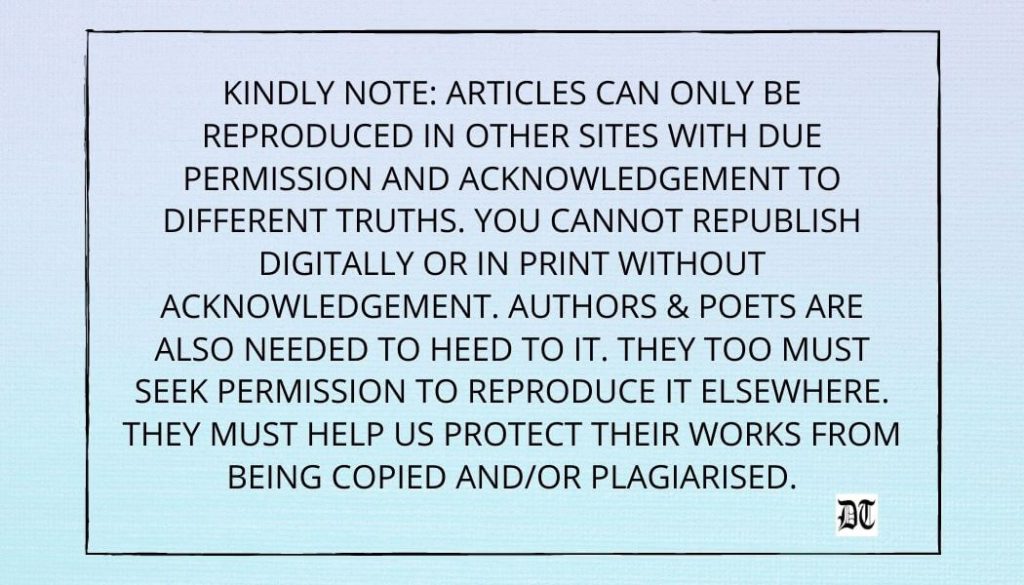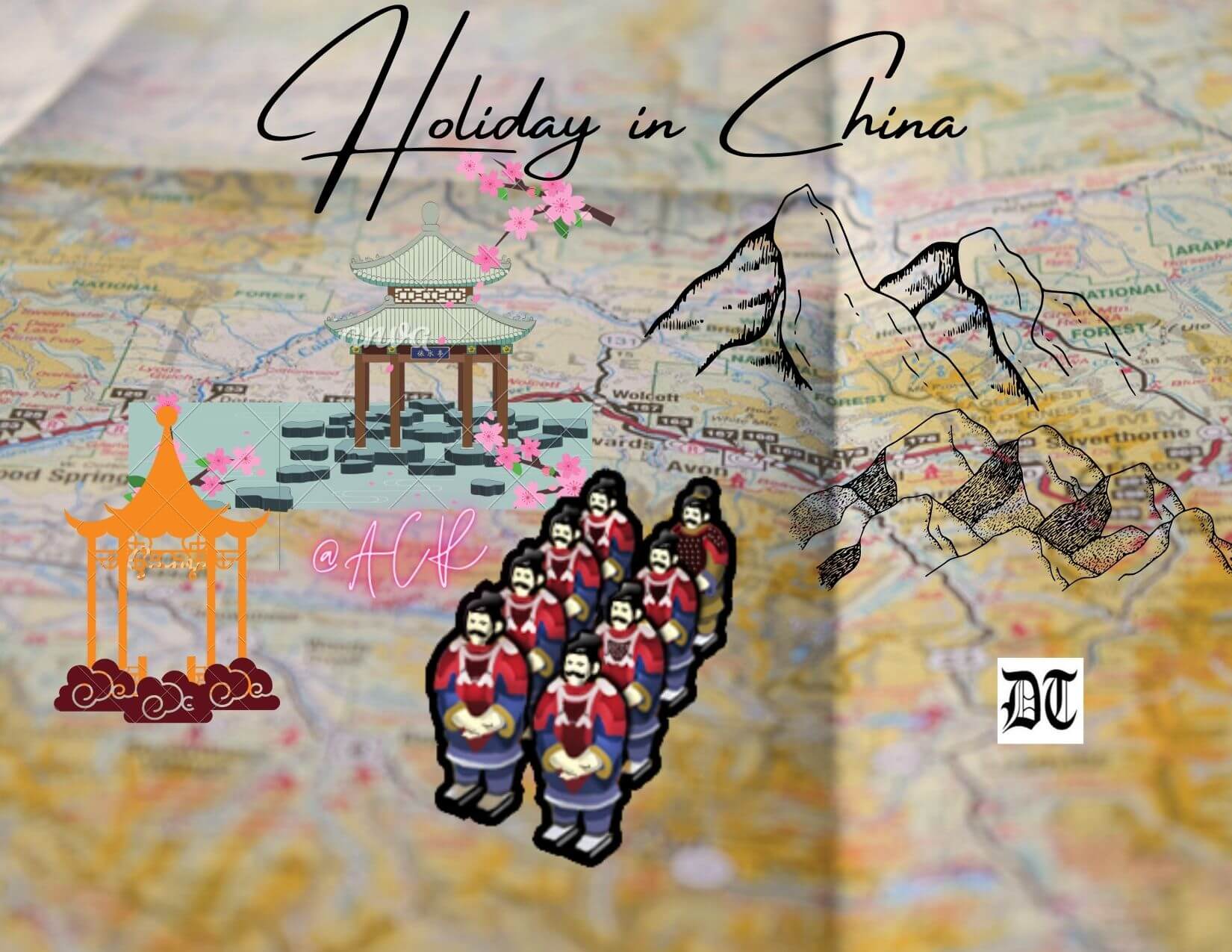Reading Time: 10 minutes
Mitali explores China during holidays to unveil its history, culture, kings, and people with a dash of humour, in the third part of the series of her book of essays, In the Land of Dragons. An exclusive from Different Truths.

I love to travel and explore new places… whether on a cloud, in my imagination or by aeroplanes and cars. Our family travelled during the school holidays. That was of course before the onset of the pandemic. Now I wander to places virtually, in my imagination and as part of a nostalgic journey into the past.
When we moved to China, we decided we would see as much of China as possible because there was a possibility that we would not venture back there too often after we returned to Singapore for good. The first place we visited was Hangzhou, a scenic spot and only a three-hour journey by road from Suzhou where we were located. The journey down to the city was fairly smooth with a second halt near the toll gates where our driver like others decided to unload himself by the roadside… but that is a common sight in places like India too. We were seasoned and ignored the halt.
We travelled to Hangzhou on the first of May, the first day of the famed May Day holidays. It was so crowded within the city that the car moved at two kilometres an hour. It might have been quicker to walk. The human population and vehicle population were overwhelming. The lakes and the mountains that were legendary for their natural splendour were covered with human population like a cookie on the ground would be with ants. The view was lost on us and to us. It had been a strange short foray into the world of holidaymakers within China. May 1, October 1, and the Chinese New Year are holidays when all of China is out celebrating, a time when crowds conquer most tourist spots.
The first time we went to Beijing was also around the October holidays. We thought, being Indians, we would be used to crowds – no fears. And then, surprise, surprise! It was worse than Hangzhou. We were sandwiched in a crowd and had to move like the stuffing between two pieces of bread with the flow of the crowd.
The first time we went to Beijing was also around the October holidays. We thought, being Indians, we would be used to crowds – no fears. And then, surprise, surprise! It was worse than Hangzhou. We were sandwiched in a crowd and had to move like the stuffing between two pieces of bread with the flow of the crowd. We were visiting the Summer Palace on October 1 and all we got to see in it were the swarming mills of heads around us. However, a few years down the line, we went to Beijing again during the October holidays with my mother-in-law because that was the only time my sons and husband could get away from school and work. We went by train on October 1. That was not too bad, as we could evade the crowds in the superfast five-hour train journey. The next day, we went to Mutianyu again, a distant gate to the Great Wall. It was crowded but still doable. On the third, we gave a car tour to my mother-in-law of the Forbidden City and Tiananmen. We did not get out of the car because all we could see was a colourful stream of people swirling around the tourist spots like water in a brook! This time, because we anticipated this, we were wise enough not to get out of the car and explore near any of the sought-after sights.
However, we did get to see the famed Olympic Bird’s Nest and Water Cube at close range at 9 a.m. These were not overcrowded then, but the crowds were building up while we were on our way out, and they had built up already when we reached Tiananmen Square and the Forbidden City!
December holidays are a good time to travel in China. The weather is pleasant, and people are working, as they do not have Christmas holidays or even a one-day holiday on Christmas.
We visited Xi’an and Guilin in December and had wonderful experiences. Both of these places have fabulous and unusual mountains.
Xi’an, of the terracotta warrior fame, has the fabulous Li Shan mountains from which were made the mud soldiers to guard the tomb of the legendary Yellow Emperor. There is even a famous Hollywood movie, The Mummy: Tomb of the Dragon Emperor, which is based on a mythical, evil terracotta king.
Xi’an, of the terracotta warrior fame, has the fabulous Li Shan mountains from which were made the mud soldiers to guard the tomb of the legendary Yellow Emperor. There is even a famous Hollywood movie, The Mummy: Tomb of the Dragon Emperor, which is based on a mythical, evil terracotta king. Of course, the real terracotta warriors were made for a king who was both cruel and self-made. He was the famous first emperor of China, Shi Huang Di, who lived more than 2200 years ago, around the same time that Asoka of the Mauryas1 ruled in India.
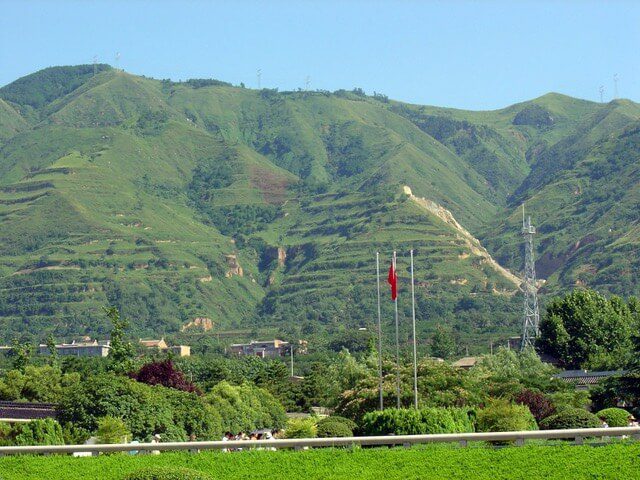
Films have been made about both Qin Shi Huang Di2 and Asoka. They both began their careers as great warriors and emperors. Asoka inherited his father and grandfather’s kingdom. Shi Huang Di had to create his own empire by conquering six kingdoms. Asoka left behind messages of peace, Buddhist stupas, and an unstable empire that lasted for about half a century. Shi Huang Di left behind the fabulous terracotta warriors to protect him in death and an unstable empire that did not last even another decade.
By the time he died, Shi Huang Di was one of the most feared and secretive persons in China. His second son, who took over, was misguided enough by his advisers to ape his father and outdo him in cruelty. As a result, he was overthrown, and his father’s grave was raided and set afire. There are legends about how his workers, concubines, and birds were buried with the king to serve him in the afterlife.
By the time he died, Shi Huang Di was one of the most feared and secretive persons in China. His second son, who took over, was misguided enough by his advisers to ape his father and outdo him in cruelty. As a result, he was overthrown, and his father’s grave was raided and set afire. There are legends about how his workers, concubines, and birds were buried with the king to serve him in the afterlife. The whole grave, which was like a miniature palace, has not been excavated fully for fear of ruining the legendary statues.
One of the first things we explored when we came to China were these warriors. For that, we made a trip to Xi’an, which in my estimation is one of the friendliest and nicest cities with ancient history dating back six thousand years. Other than Shi Huang Di’s mud army, one of the most ancient and fascinating finds are found in the Banpo Museum, which housed the skeletons and remains of a six-thousand-year-old civilization found in China. This Neolithic civilization was largely matriarchal. They had strange marriage customs, which included no concept of commitment. A boy walked into the girl’s home and woke up the next morning and went back to normal life at his mother’s in the daytime. A girl could have as many partners as she wanted, and a child born of her knew only his or her mother but not the father. I have read of this kind of marriage in fiction3 where the author, Rahul Sankrityayan, tried to recreate stories of Indo-Europeans set around 6000BCE on the upper banks of the Volga. These are people he shows who travelled down to populate India. And the interesting thing is this kind of marriage still exists in the Yunnan province of China4.
The other interesting thing that we saw in Xi’an was the Huaqing Springs Palace. Its history dates from the Zhou dynasty (eleventh century BCE to 711 BCE) when the Yellow Emperor built a palace here. Of course, additions were made by the first emperor in his lifetime, but nothing that one would notice compared to the terracotta men.
The other interesting thing that we saw in Xi’an was the Huaqing Springs Palace5. Its history dates from the Zhou dynasty (eleventh century BCE to 711 BCE), when the Yellow Emperor built a palace here. Of course, additions were made by the first emperor in his lifetime, but nothing that one would notice compared to the terracotta men. Then various members added embellishments. What we see today was built by the Tang dynasty emperor Xuanzong for his concubine Yang Gufei in the seventh century CE. Yang Gufei is listed as one of the four most beautiful women in China. What I found strange was that people revere her almost like a goddess. If you go into her history, you learn that it’s murky and sordid. It seems she was married to Xuanzong’s son to start with. The emperor saw her and fell in love with her. She was sent to a nunnery for five years and then reinstated as the emperor’s concubine! It seems the emperor composed poems set to music and she danced to the compositions. Wow! How acceptable is that to you?
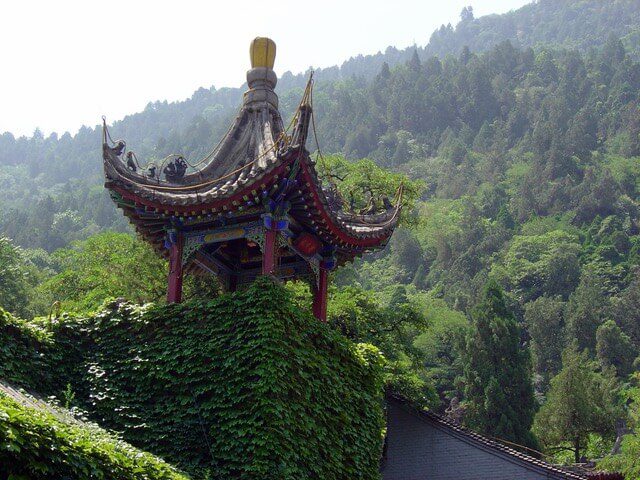
However, the emperor not only built a fabulous palace at the foot of Mount Lishan for his beloved but also had a series of pools of different shapes filled with water from the hot springs of Huaqing for his beloved ex-daughter-in law turned concubine. This palace also housed Cixi, the last empress of China, at the turn of the twentieth century, and then later, in 1936, Chiang Kai-Shek hid here on his way out of China. On the glass panels of the windows that housed his rooms and office are bullet holes left by the Japanese soldiers as the Kuomintang leader escaped from the palace to the hills and then to Taiwan. From a distance, these ancient hills appear pyramid-like, with green grass growing on them. The shape makes the hills look smooth and manmade from far. Closer, of course, there are uneven rocks, and the ascent is quite steep.
A fabulous guide took us around the Banpo civilisation, Huaqing palace, and the terracotta warriors. She spoke in English and made history come alive for us. She was fabulous in every respect except for her choice of food. She insisted we savour local cuisine the day we went to Huaqing Springs, an experience I would prefer not to repeat.
A fabulous guide took us around the Banpo civilisation, Huaqing palace, and the terracotta warriors. She spoke in English and made history come alive for us. She was fabulous in every respect except for her choice of food. She insisted we savour local cuisine the day we went to Huaqing Springs, an experience I would prefer not to repeat. The food was oily beyond imagination. One thing I know for certain is that experimenting with cuisines is risky in China. Once, when we were new to China, we went to a Sichuanese restaurant in Suzhou, mistaking it for a Schezwan (Cantonese) restaurant, and the next day I was swollen with urticaria and had to take a ten-minute intravenous injection to come back to my normal state.
However, there was no such risk with the local food in Xi’an, as I could not eat anything much! My boys practically lunched on ice cream. The first day, we went to a restaurant near the warriors. It was what they refer to as an international buffet and not so bad. What was interesting in that area were the tourist souvenirs. We got some lovely hand-painted peacock teacups. The next day our guide took us terracotta warrior shopping.
They have a separate outlet for making the warriors. The mud used by them is from Mount Lishan, the same that was used to create the Qin emperor’s statues more than two thousand years ago. The two-thousand-year-old techniques are still used to recreate the warriors in that factory. My younger son was excited at this outlet. He posed with the warriors and statues
They have a separate outlet for making the warriors. The mud used by them is from Mount Lishan, the same that was used to create the Qin emperor’s statues more than two thousand years ago. The two-thousand-year-old techniques are still used to recreate the warriors in that factory. My younger son was excited at this outlet. He posed with the warriors and statues. My husband thought it would be fabulous to have some life-size statues. Then I reminded him of our mobile lives, and he was forced to settle for a smaller set of five, with the emperor and his four ranks of warriors, which was more suited to our short-term housing lifestyle. The distinctive thing about these statues is that no two of them are identical. It seems the statues are modelled on the real soldiers in the army.
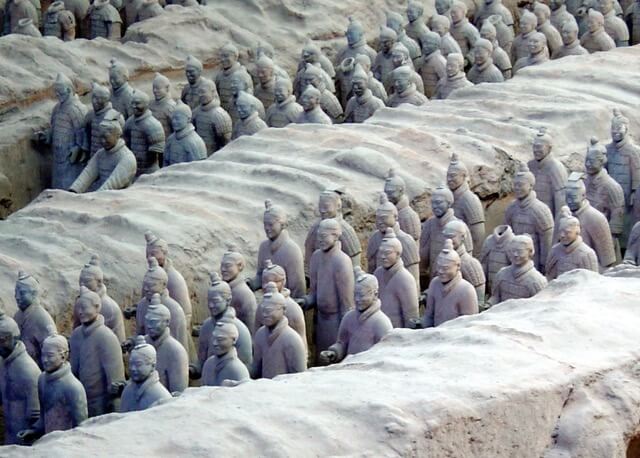
When we went to the museums, we discovered that we could not go close to the statues. We had to watch from a balcony; the statues stood in a kind of pit. But we had a totally enjoyable experience. There were a number of pits, each exhibiting different types of soldiers and formations. We could not go close to them, as Bill Clinton had when he visited as the president of the United States, or Pablo Wendel2, a German performance artist. It seems that Pablo Wendel was so fascinated by the soldiers that he dressed up as one of them in 2006 and stood in a gap in the line of the ancient warriors. He blended in so well with these terracotta gentlemen that it was a short while before the present-day living soldiers walked up to him and asked him to leave. But as Wendel was a statue during his performance, he refused to respond. Then six of the present-day soldiers carried him out on their shoulders. Eventually, his clothes were confiscated, and he was sent packing in borrowed clothes!
Strange, isn’t it – wanting to be a terracotta warrior? But to plan and have the courage to execute what he really wanted is what makes Wendel’s story interesting.
Strange, isn’t it – wanting to be a terracotta warrior? But to plan and have the courage to execute what he really wanted is what makes Wendel’s story interesting. I wonder how many of us have the guts to do what we really want. Did the first emperor have the guts to do what he really wanted deep within his heart? Did his contemporary Asoka have guts to stick to his convictions and materialise his dreams?
References:
1. https://www.encyclopedia.com/people/history/south-asian-history-biographies/asoka
2. The Terracotta Army by John Man, Bantam Press, published in 2007 https://www.goodreads.com/book/show/2233771.The_Terracotta_Army
3. From Volga to Ganga, translated by Victor Kierman, Pilgrim Publishing, 2006. The original book, originally written by Rahul Sanskratayana and published in 1947. https://books.google.com.sg/books/about/From_Volga_to_Ganga.html?id=4Yf7GwAACAAJ&redir_esc=y
5. Xi’An – One of the four Ancient Capitals in the World, Shaanxi Tourism Press, China, ISBN: 7-5418-1688-4
Visuals by Different Truths and photographs by author.
